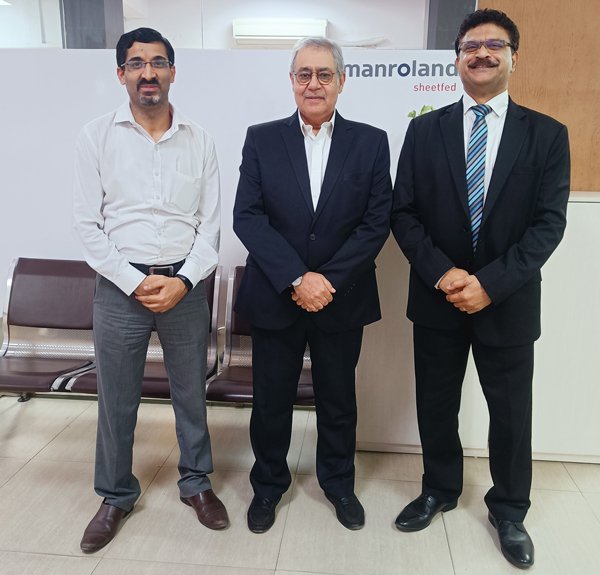
Manroland Sheetfed India announced several additions to its senior personnel in the country in late November in what could be understood as an escalation of interest in the Indian and South Asian markets. Manroland Sheetfed is one of the few companies that added resources in the past two years notwithstanding the economic ambiguity of the past two pandemic-ridden years, anticipating an increase in sheetfed press demand with the eventual resumption of economic growth.
AJ Langley, chairman of Langley Holdings stated in the company’s 2020 Annual Report, “The Manroland business has a lower cost base and, in contrast to its competitors, is saddled with neither debt nor disproportionate overhead costs.” R&D investments continued since the Langley group took over Manroland Sheetfed in 2012 and led to the introduction of the Evolution series of presses in 2016. The enhanced Evolution series, ready for introduction at drupa 2000, have reached customers globally in the past year. The increased interest and investments in the Indian market can be seen in this context, and also in the context of Manroland Sheetfed’s ‘gloves off’ approach to competition that its owner spoke about in 2020.
The Indian sheetfed offset market for new multicolor presses which reached levels of more than 80 machines a few years ago, has shrunk considerably in the past three years, including the two pandemic years. Nevertheless, packaging has done well and we were curious as to how Manroland Sheetfed India is looking at accelerating its fight back in this market.
Investors will look for higher productivity
Peter Rego the new business development director of the company, says that the Indian monocarton industry is becoming more organized and structured. “It has started attracting stronger levels of investment including foreign private equity investment,” he says. An aspect of this more structured investment according to him is that investors will be looking to increase productivity and at the VLF format such as the Roland R 900 series, which he claims is four times as productive as the B1 format. In addition, he is confident that the company can retake the high ground both in the VLF formats and its reputation in carton printing where the R 700 series was, at one time, the benchmark of the industry.
Rego says, “Manroland has been in the VLF business since the ’70s and has over the years modernized its presses, with the latest VLF R 900 Evolution press launched in Dec 2020. We know that the print quality on this press is the best in its class due to its robust and precise metallurgy and advanced technology. We see a great future in the VLF format size presses with the increased industrialization of print, resulting in high-performance print and converting businesses reducing touch points and labor force with more automation due to the shortage of skilled manpower.”
We ask Rego about the reluctance of the Indian packaging market to invest in VLF presses because of the downstream limitations or fears of converting larger sheets. Here, he says quite convincingly, that because the R 900 Evolution has a slitting device at the delivery, existing die-cutters will handle the first step of converting. He adds that a larger CtP will be needed in the prepress department to make the bigger plates. What he doesn’t say is that with increased productivity, more folder-gluers may also be needed.
“The R 900 is capable to give you 4 ups of 52 x 72 centimeter size (highly interesting for alcobev cartons) which on a 105/106 press would give you only one up or in the best scenario, two. Since one team is needed to run the press, there is a huge reduction in labor, space, power, and other costs – just a few of the benefits from the VLF R 900 press,” he says, and adds, “We see this trend around the globe where large industrial packaging plants are investing in the R 900 format. Manroland has sold more than 3,000 units in the VLF format and with the recently launched R 900 Evolution press with all the unmatched top-class automation and a speed of 16,500 sheets per hour, we see a huge potential for this size in our market as well.”
R 700 Evolution – flexible configurations and consumable free for life!
On the standard size press for Indian monocarton printing, Rego says he is confident that the R 700 Evolution is the most flexible and best-automated press in its class. “We can offer four different sheet size options depending on your job requirement with speeds ranging from 15,000 to 20,000 sheets per hour, capable of printing on sheets from 0.04 mm right up to 1.2 mm, depending on your run lengths, and customer segments. Last year Manroland launched its ‘Triple Flow Ink’ technology for this format which is claimed to eliminate color fading or banding from the leading edge to the tail of the sheet caused by certain designs and colors.
“Hence the most flexible press in its class, the R 700 comes CIP4 ready and can be connected to any prepress system, without any recurring costs or licence fees, for life. The punchline is that the Manroland R 700 Evolution is consumable free for life! No recurring costs, no downtime due to consumables replacement due to wear and tear. Resulting in optimum productivity with top-class print quality.”
To be more customer-centric and responsive, Manroland India’s managing director Neeraj Dargan has already increased the company’s resources and strengthened the service, spare parts, and logistics teams. Three more engineers have been added, taking the team to nine. Manroland Sheetfed is aware that India is a very competitive market and it seems that Rego and Dargan have a strategy. They are ready to compete on features, service, and all other aspects to gain market share in what is a hot packaging market. One that is attracting interest from both global brands looking to grow volumes and investors keen to leverage the growth that will require structure and capital.









